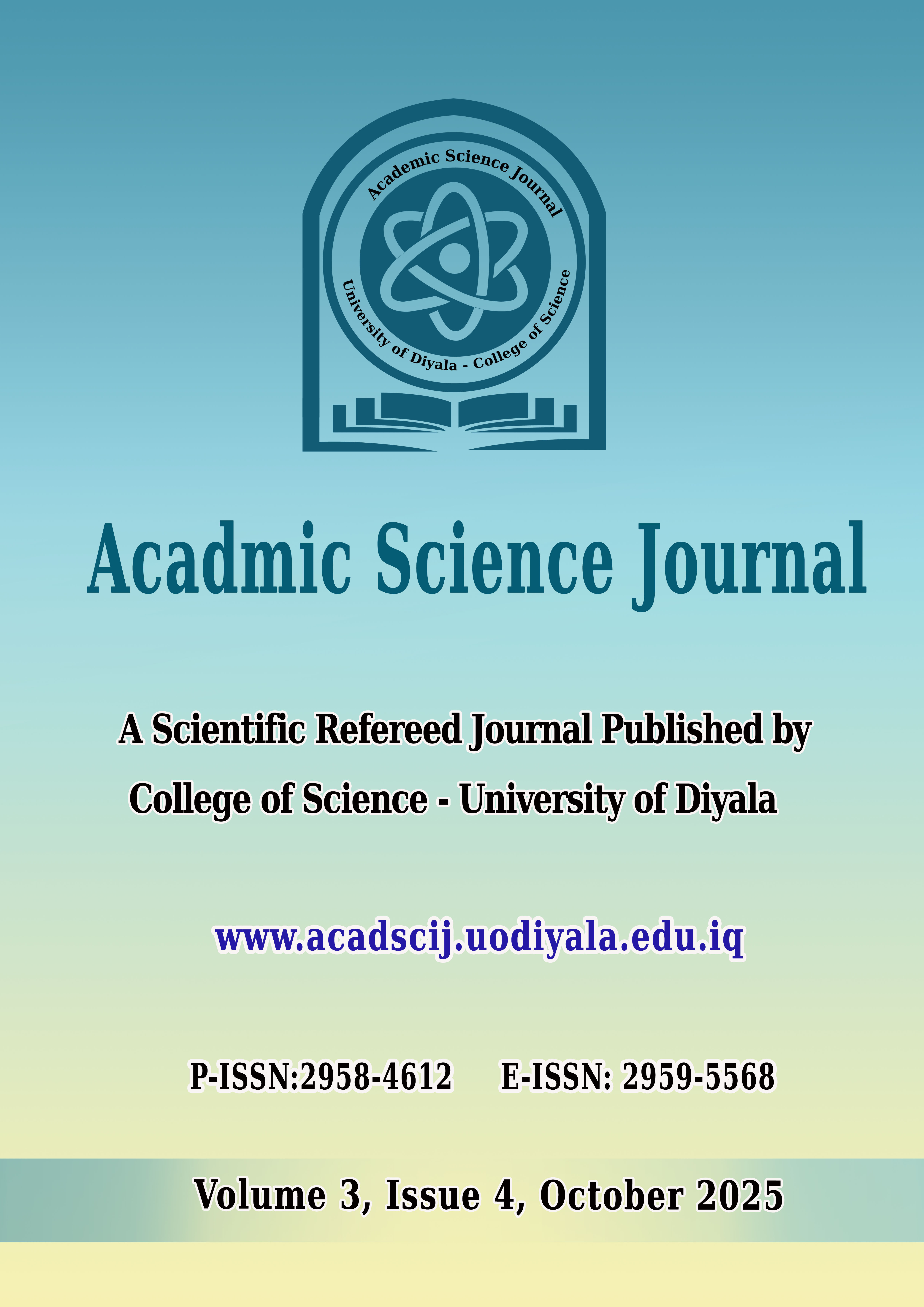Preparation and Study of Zinc Oxide Nanoparticles to Evaluate TheirAntioxidant Activity
DOI:
https://doi.org/10.24237/ASJ.03.04.923BKeywords:
ZnO NPs , Antioxidants , Cytotoxicity . chemo mechanical method .Abstract
Zinc oxide nanoparticles were prepared by chemical reaction method, which is one of the methods that does not require high temperatures during preparation. The prepared particles were tested by X-ray diffraction (XRD) spectroscopy and UV-vis spectroscopy (FESEM) was performed and the antioxidant behavior of ZnO nanoparticles was evaluated by free radical scavenging of 2,2-diphenyl-1-picrylhydrazyl hydrate ( DPPH) at different nanoparticle concentrations and a discrete time interval. The DPPH scavenging activity was monitored by UV spectrophotometry and ZnO nanoparticles showed good antioxidant activity.
Downloads
References
[1] A. Nel, T. Xia, L. Madler, N. Li, Toxic potential of materials at the nanolevel, Science, 311(5761), 622-627(2006), DOI(https://doi.org/10.1126/science.1114397)
[2] W. R. Bowen, R. W. Lovitt, C. J. Wright, Application of atomic force microscopy to the study of micromechanical properties of biological materials, Biotechnology Letters, 22, 893-903(2000), DOI(https://doi.org/10.1023/A:1005604028444)
[3] P. Avouris, Manipulation of matter at the atomic and molecular levels, Accounts of chemical research, 28(3), 95-102(1995)
[4] V. L. Colvin, The potential environmental impact of engineered nanomaterials, Nature Biotechnology, 21(10), 1166-1170(2003), DOI(https://doi.org/10.1038/nbt875)
[5] Z. Chen, H. Meng, G. Xing, C. Chen, Y. Zhao, Toxicological and biological effects of nanomaterials, International journal of nanotechnology, 4(1-2), 179-196(2007)
[6] K. J. Davies, Protein damage and degradation by oxygen radicals, I. general aspects. Journal of Biological Chemistry, 262(20), 9895-9901(1987)
[7] J. M. Gutteridge, D. A. Rowley, B. Halliwell, Superoxide-dependent formation of hydroxyl radicals in the presence of iron salts. Detection of ‘free ’iron in biological systems by using bleomycin-dependent degradation of DNA, Biochemical Journal, 199(1), 263-265(1981), DOI(https://doi.org/10.1042/bj1990263)
[8] P. A. Rea, J. Crowe, Y. A. B. D. Wickramasinghe, P. Rolfe, Non-invasive optical methods for the study of cerebral metabolism in the human newborn: a technique for the future?, Journal of medical engineering & technology, 9(4), 160-166(1985), DOI(https://doi.org/10.3109/03091908509032600)
[9] R. L. Baldwin, Estimation of theoretical calorific relationships as a teaching technique: A review, Journal of Dairy Science, 51(1), 104-111(1968), DOI(https://doi.org/10.3168/jds.S0022-0302(68)86928-0)
[10] G. W. Winston, F. Regoli, A. J. Jr. Dugas, J. H. Fong, K. A. Blanchard, A rapid gas chromatographic assay for determining the oxyradical scavenging capacity of antioxidants and biological fluid, Free Radical Biology and Medicine, 24(3), 480-493(1998), DOI(https://doi.org/10.1016/s0891-5849(97)00277-3)
[11] C. S. Ryu, C. H. Kim, S. Y. Lee, K. S. Lee, K. J. Choung, G. Y. Song, S. K. Kim, Evaluation of the total oxidant scavenging capacity of saponins isolated from Platycodon grandiflorum, Food Chemistry, 132(1), 333-337(2012), DOI(https://doi.org/10.1016/j.foodchem.2011.10.086)
[12] F. Regoli, M. Nigro, S. Bompadre, G. W. Winston, Total oxidant scavenging capacity (TOSC) of microsomal and cytosolic fractions from Antarctic, Arctic, and Mediterranean scallops: differentiation between three potent oxidants, Aquatic Toxicology, 49(1-2), 13-25(2000), DO(https://doi.org/10.1016/j.foodchem.2011.10.086)
[13] S. S. J. P. Paul, J. P. Saikia, S. K. Samdarshi, B. K. Konwar, Investigation of antioxidant property of iron oxide particles by 1′-1′ diphenylpicryl-hydrazyle (DPPH) method, Journal of Magnetism and Magnetic Materials, 321(21), 3621-3623(2009), DOI(https://doi.org/10.1016/j.jmmm.2009.07.004)
[14] NK. Hemanth Kumar, M. Murali, A. Satish, S. Brijesh Singh, HG. Gowtham, HM. Mahesh, Bioactive and biocompatible nature of green synthesized zinc oxide nanoparticles from Simarouba glauca DC.: an endemic plant to Western Ghats, India. J Clust Sci., 31, 523–34(2020), DOI(https://doi.org/10.1007/s10876-019-01669-7)
[15] S. Banerjee, J. P. Saikia, A. Kumar, B. K. Konwar, Antioxidant activity and hemolysis prevention efficiency of polyaniline nanofibers, Nanotechnology, 21(4), 045101(2009), DOI(https://doi.org/10.1088/0957-4484/21/4/045101)
[16] D. Das, B. C. Nath, P. Phukon, S. K. Dolui, Synthesis of ZnO nanoparticles and evaluation of antioxidant and cytotoxic activity, Colloids and Surfaces B: Biointerfaces, 111, 556-560(2013), DOI(https://doi.org/10.1016/j.colsurfb.2013.06.041)
[17] M. A. Dobrovolskaia, J. D. Clogston, B. W. Neun, J. B. Hall, A. K. Patri, & S. E. McNeil, Method for analysis of nanoparticle hemolytic properties in vitro, Nano letters, 8(8), 2180-2187(2008), DOI(https://doi.org/10.1021/nl0805615)
[18] S. Syama, S. C. Reshma, P. J. Sreekanth, H. K. Varma, & P. V. Mohanan, Effect of zinc oxide nanoparticles on cellular oxidative stress and antioxidant defense mechanisms in mouse liver, Toxicological & Environmental Chemistry, 95(3), 495-503(2013), DOI(http://dx.doi.org/10.1080/02772248.2013.789606)
[19] D. Guo, C. Wu, H. Jiang, Q. Li, X. Wang, & B. Chen, Synergistic cytotoxic effect of different sized ZnO nanoparticles and daunorubicin against leukemia cancer cells under UV irradiation, Journal of Photochemistry and Photobiology B: Biology, 93(3), 119-126(2008), DOI(https://doi.org/10.1016/j.jphotobiol.2008.07.009)
[20] D. Das, B. C. Nath, P. Phukon, & S. K. Dolui, Synthesis and evaluation of antioxidant and antibacterial behavior of CuO nanoparticles, Colloids and Surfaces B: Biointerfaces, 101, 430-433(2013), DOI(https://doi.org/10.1016/j.colsurfb.2012.07.002)
[21] A. Serpen, E. Capuano, V. Fogliano, & V. Gökmen, A new procedure to measure the antioxidant activity of insoluble food components, Journal of agricultural and food chemistry, 55(19), 7676-7681(2007), DOI(https://doi.org/10.1021/jf071291z)
[22] M. K. Sharp, & S. F. Mohammad, Scaling of hemolysis in needles and catheters, Annals of biomedical engineering, 26, 788-797(1998), DOI(https://doi.org/10.1114/1.65)
[23] M. Miki, H. Tamai, M. Mino, Y. Yamamoto, & E. Niki, Free-radical chain oxidation of rat red blood cells by molecular oxygen and its inhibition by α-tocopherol, Archives of Biochemistry and Biophysics, 258(2), 373-380(1987), DOI(https://doi.org/10.1016/0003-9861(87)90358-4)
[24] A. Mishra, & N. Chaudhary, Study of povidone-iodine loaded hydrogels as wound dressing material, Trends Biomater Artif Organs, 23(3), 122-128(2010)
[25] P. D. File, Joint committee on powder diffraction standards, ASTM, Philadelphia, Pa, 9-185(1967)
[26] K. K. Taha, M. M. Mustafa, H. A. M. Ahmed, S. Talab, Selenium zinc oxide (Se/ZnO) nanoparticles: Synthesis, characterization, and photocatalytic activity, Z. Nat. A , 74, 1043–1056(2019), DOI(https://doi.org/10.1016/j.onano.2022.100082)
[27] V. Petkov, T. Ohta, Y. Hou, & Y. Ren, Atomic-Scale Structure of Nanocrystals by High-Energy X-ray Diffraction and Atomic Pair Distribution Function Analysis: Study of Fe x Pd100-x (x= 0, 26, 28, 48) Nanoparticles, The Journal of Physical Chemistry C, 111(2), 714-720(2007), DOI(https://doi.org/10.1021/jp066166p)
[28] P. Gnanamoorthy, V. Karthikeyan, V. A. Prabu, Field Emission Scanning Electron Microscopy (FESEM) characterization of the porous silica nanoparticulate structure of marine diatoms, Journal of Porous Materials, 21, 225-233(2014), DOI(https://doi.org/10.1007/s10934-013-9767-2)
[29] V. Srivastava, D. Gusain, YC. Sharma, Synthesis, characterization, and application of zinc oxide nanoparticles (n-ZnO), Ceram Int., 39(8), 9803-9808(2013), DOI(https://doi.org/10.1016/j.ceramint.2013.04.110)
[30] S. Jafarirad, M. Mehrabi, B. Divband, M. Kosari-Nasab, Biofabrication of zinc oxide nanoparticles using fruit extract of Rosa canina and their toxic potential against bacteria: a mechanistic approach, Mater Sci Eng C Mater Biol Appl., 59, 296–302(2016), DOI(https://doi.org/10.1016/j.msec.2015.09.089)
[31] D. Das, B. C. Nath, P. Phukon, & S. K. Dolui, Synthesis of ZnO nanoparticles and evaluation of antioxidant and cytotoxic activity, Colloids and Surfaces B: Biointerfaces, 111, 556-560(2013), DOI(https://doi.org/10.1016/j.colsurfb.2013.06.041)
[32] T. Riaz, R. Zeeshan, F. Zarif, K. Ilyas, N. Muhammad, S. Z. Safi, I. U. Rehman, FTIR analysis of natural and synthetic collagen, Applied Spectroscopy Reviews, 53(9), 703-746(2018), DOI(https://doi.org/10.1080/05704928.2018.1426595)
[33] D, Suresh, RM. Shobharani, PC. Nethravathi, MA. Pavan Kumar, H. Nagabhushana, SC. Sharma, Artocarpus gomezianus aided green synthesis of ZnO nanoparticles: luminescence, photocatalytic, and antioxidant properties, Spectrochim Acta A Mol Biomol Spectrosc, 141, 128–34(2015), DOI(https://doi.org/10.1016/j.saa.2015.01.048)
[34] P. Prieto, M. Pineda, & M. Aguilar, Spectrophotometric quantitation of antioxidant capacity through the formation of a phosphomolybdenum complex: specific application to the determination of vitamin E, Analytical biochemistry, 269(2), 337-341(1999), DOI(https://doi.org/10.1006/abio.1999.4019)
[35] R. Singh, S. Singh, S. Kumar, & S. Arora, Evaluation of the antioxidant potential of ethyl acetate extract/fractions of Acacia auriculiformis A. Cunn, Food and chemical toxicology, 45(7), 1216-1223(2007), DOI(https://doi.org/10.1016/j.fct.2007.01.002)
[36] A. Venkateasan, R. Prabakaran, V. Sujatha, Phytoextractmediated synthesis of zinc oxide nanoparticles using aqueous leaves extract of Ipomoea pes-caprae (L). R. br revealing its biological properties and photocatalytic activity, Nanotechnol Environ Eng., 2, 8(2017), DOI(https://doi.org/10.1007/s41204-017-0018-7)
[37] A. Es-haghi, F. Javadi, M. E. T. Yazdi, & M. S. Amiri, The expression of antioxidant genes and cytotoxicity of biosynthesized cerium oxide nanoparticles against hepatic carcinoma cell line, Avicenna Journal of Medical Biochemistry, 7(1), 16-20(2019), DOI(https://doi.org/10.34172/ajmb.2019.04)
[38] L. A. Pham-Huy, H. He, & C. Pham-Huy, Free radicals, antioxidants in disease and health, International journal of biomedical science: IJBS, 4(2), 89(2008)
[39] M. DJ, V. Vinaykiya, V. B. Dutta, S., R. Pawar, & V. B. Raghavendra, Screening of antibacterial and antioxidant activity of biogenically synthesized silver nanoparticles from Alternaria alternata, endophytic fungus of Dendrophthoe falcata-a parasitic plant, BioNanoScience, 12(1), 128-141(2022), DOI(https://doi.org/10.1007/s12668-021-00932-4)
[40] Z. K. Taha, S. N. Hawar, & G. M. Sulaiman, Extracellular biosynthesis of silver nanoparticles from Penicillium italicum and its antioxidant, antimicrobial, and cytotoxicity activities, Biotechnology letters, 41, 899-914(2019), DOI(https://doi.org/10.1007/s10529-019-02699-x)
Downloads
Published
Issue
Section
License
Copyright (c) 2025 CC BY 4.0

This work is licensed under a Creative Commons Attribution 4.0 International License.





